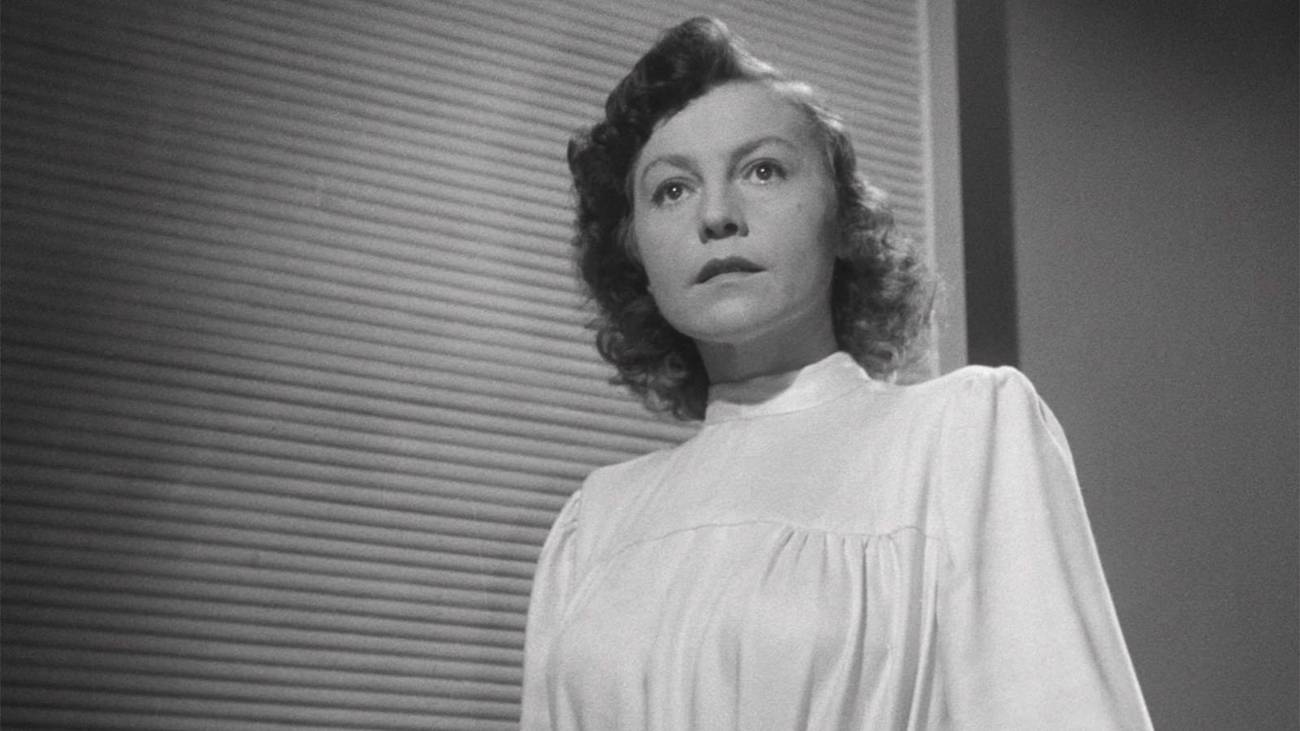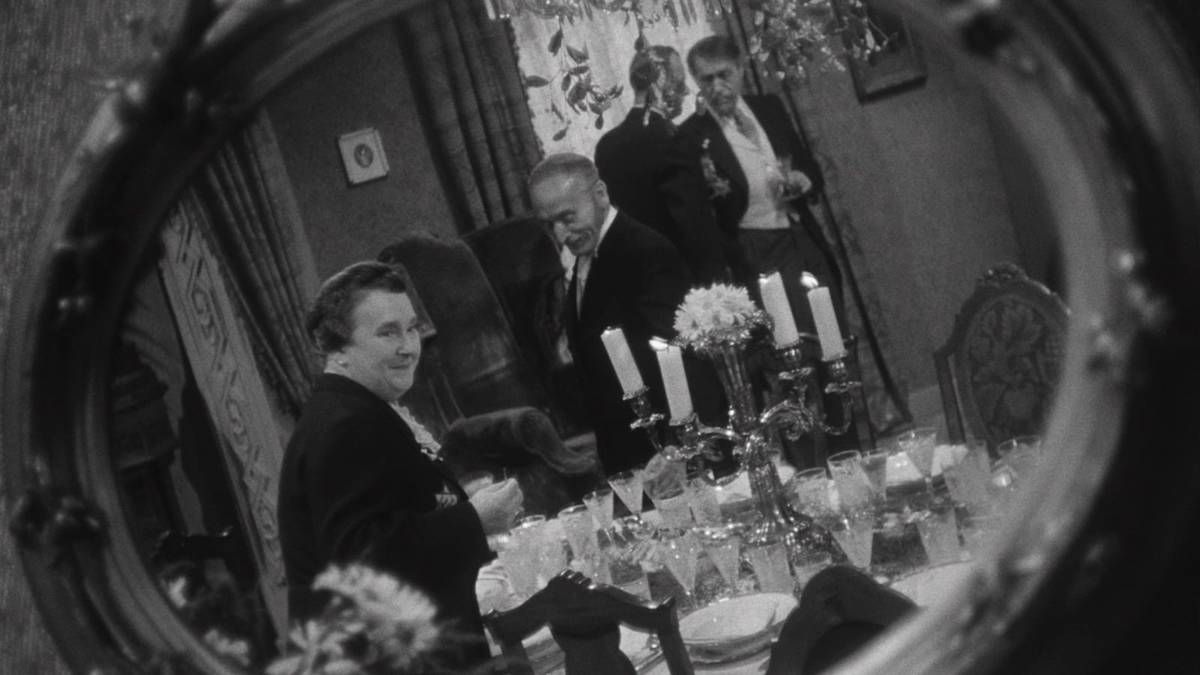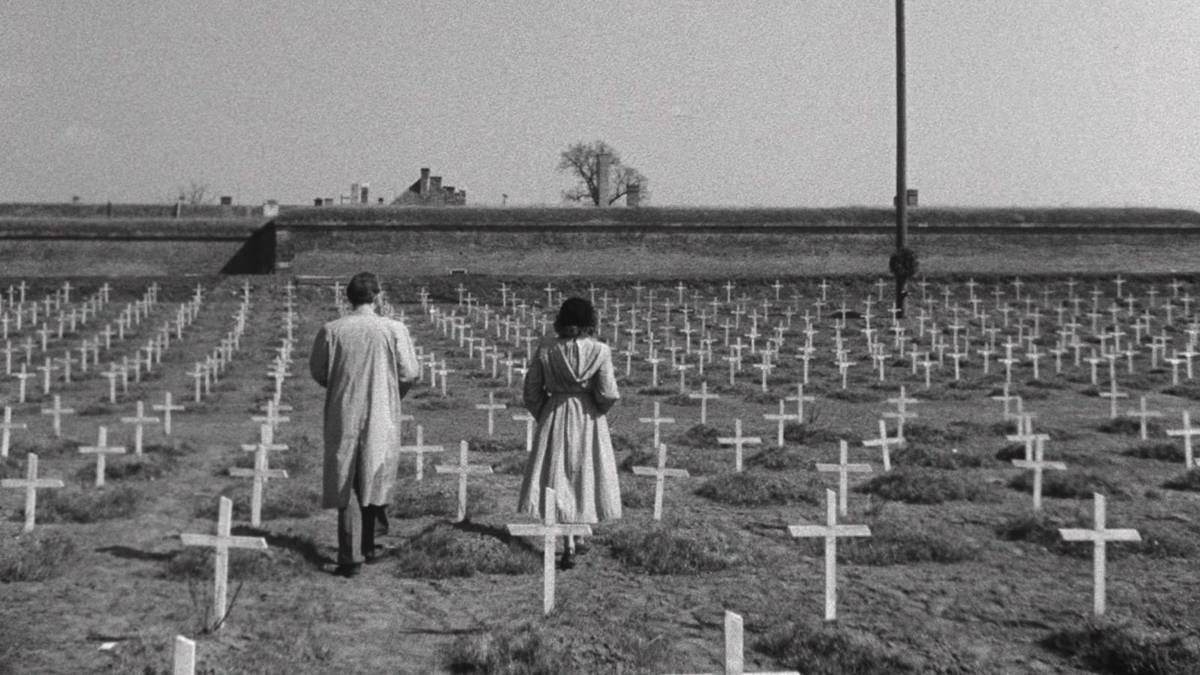Life With a Star
The 1949 Czech film ‘Distant Journey’ was one of the first movies to dramatize the Shoah. Banned for decades and recently restored, its depiction of Nazi horrors is still one of the most striking.



Alfred Radok’s 1949 first feature, Distant Journey, was (and is) a landmark—a movie of its time that continues to speak to ours. Made in a no longer extant, once-communist state during the Cold War winter of 1948-1949, Radok’s remarkable debut is a masterpiece of Czech cinema. It was also one of the first and remains among the strongest, most original, and most influential movies to deal with the murder of European Jewry.
Distant Journey had its New York premiere in August 1950, not three months into the Korean War, at the Stanley, a shabby theater off Times Square that then served as the home of Yiddish movies, Israeli documentaries, and Soviet imports. The film was given the Yiddish title Geto Terezin, for the “transit camp” Theresienstadt, known in Czech as Terezin, where it was largely set and partially filmed; it was so enthusiastically received that it was held for over a month.
The New York Times critic Bosley Crowther called Distant Journey “the most brilliant, the most powerful and horrifying film on the Nazis’ persecution of the Jews,” that he had ever seen, albeit cautioning “the faint of heart” to see the movie “at their own risk.” The Yiddish daily Morgn Frayhayt reported the amazed public response of at least one spectator who claimed to recognize her fictionalized self on the screen—as well she might. The first fiction films to represent the Holocaust, produced in Eastern Europe soon after the war were typically made by and/or with actual survivors. All had aspects of psychodrama, docudrama, and documentary.
Nothing if not personal, Distant Journey was written by Erik Kolár, an assimilated Czech Jewish lawyer who, married to a gentile, managed to stave off deportation to Terezin until 1945. Director Radok, the son of a Catholic mother and a Jewish father, grew up in a Bohemian village and spent much of the war in hiding before being sent to a forced labor camp for mischlings in Poland. Both his father and grandfather died in Terezin. Based on his experiences, Kolár took a conciliatory attitude toward his gentile countrymen; based on his experience, Radok did not. In its attitude and attention to detail, Distant Journey was the most Jewish film made in Czechoslovakia up until that time and perhaps ever.
Neither man had any prior involvement with film. Radok was a theater director when the newly nationalized Barrandov studio engaged him to direct Kolár’s screenplay. His film school was Citizen Kane, which had been released in Czechoslovakia after the war. (In 1947, Radok told a journalist that, for him, Kane was the year’s most profound artistic revelation.) Like Kane, Distant Journey drew on the visual language of German expressionist cinema—a stylized self-dramatizing movie of slashing shadows and shimmering reflections, mirror shots and looming angles, some so low they showed a visible ceiling.

Like Welles, but differently, Radok incorporated newsreels into his narrative, using a small frame within a frame to insert drama into documentary and vice versa. Drawing on Nazi propaganda films like Triumph of the Will, Distant Journey establishes the March 1939 occupation of Czechoslovakia in a series of quick, deft strokes—goose-stepping soldiers, antisemitic graffiti, long lines outside Western consulates—then focuses on the situation of Hana Kaufmannová, a Jewish doctor who forestalls her inevitable deportation to Terezin by marrying a gentile colleague, Toník Bureš. The choice of protagonists is crucial: Hana and Toník are exemplary modern, rational beings. Moreover, as a prelude to implementing the exclusionary Nuremberg Laws, the Nazis’ first order banned Jewish doctors from “Aryan” practices.
While mass deportation to concentration camps would begin some two years later, it seems as though, almost overnight, the comfortable, cultivated Kaufmann family and their Jewish neighbors are systematically humiliated and stripped of their rights. Hana is sent to work in a Jewish clinic; Toník loses his job as well. Their wedding dinner blends gaiety and terror—the proper bourgeois guests marked for death by their mandatory Jewish stars. Normality is further deranged by Radok’s Wellesian use of sound. Key discords echo throughout. A suicide is accompanied by a run of monotonous piano scales emanating from the apartment above. Deportations are staged as a danse macabre and set to Jiří Sternwald’s haunting martial bolero.
The film’s emptied-out world of gnarled old people, dehumanizing bureaucracy, and vast warehouses filled with confiscated Jewish belongings cannot help but evoke Franz Kafka. In that, Distant Journey has much in common with the Czech Jewish novelist Jiří Weil’s Life with a Star, published in 1949, the same year of the movie’s Czech release. After faking his own death, Weil survived the war in hiding. His fictionalized account is a dispassionate description of the process by which, for no discernible reason, a Prague bank clerk is demeaned, degraded, and cast out. (The word “Jew” is not mentioned, nor is “Nazi.”) In both novel and movie, irrationality rules. The only thing that distinguishes the Jews from their fellow Czechs is the yellow star.
No less than Life with a Star, Distant Journey belongs to what Jean-Paul Sartre called the “literature of extreme situations” and associated with Albert Camus’ 1948 novel, The Plague. Radok’s movie and Weil’s novel not only evoke Kafka’s sense of systematic dehumanization but also Camus’ brand of existentialism, defining the human condition in terms of freedom of choice and personal responsibility under sentence of death in the face of a hostile, unknowable universe. One exchange in Distant Journey could have been taken from The Plague: “I’m not waiting here for death,” one Jew tells another. The reply, “Where will you wait then?”
Life with a Star alludes to but does not venture to Terezin, the 18th-century garrison town 40 miles from Prague, whose Hapsburg facades concealed nearly 10 times as many inhabitants as it was built to house. A holding pen for well-known musicians, artists, scholars, and other “prominents,” Terezin was essentially the antechamber to extermination—a place of constant coercion, insufficient food, and terrible hygiene. Altogether, some 140,000 Jews passed through this so-called “model” concentration camp. About 33,000 died there; another 87,000 were transported on to Auschwitz.
In Distant Journey, Terezin is a process: One line enters the camp as the dead are carried out on another line. It’s also a nightmare. Space is incoherent, impossibly claustrophobic. The interiors are jerry-built. Obstructed views and enigmatic missions add to the incomprehensibility. The images of old women scrubbing the narrow pavement where terrorized children sing and ballerinas dance like automatons, or the brief glimpse of a marionette descending the crooked stairs from some secret rat’s nest are worthy of Bedřich Fritta, the graphic artist whose Terezin drawings were condemned by the Nazis as “horror pornography.”
Still, some Terezin survivors, notably Arnošt Lustig have objected to Radok’s stylization: “There was order in Terezin, not this kind of chaos,” one maintained. But in Radok’s Terezin, chaos and order are indistinguishable. The only clarity is provided by the dispassionate cruelty of the Nazi overlords.
Given that the camp was founded on deception, Radok’s use of the fantastic is a form of verisimilitude. Terezin was already a movie set. The Nazis filmed two pseudo-documentaries there. The second, shot during the summer of 1944 was preceded by months of “beautification”—buildings were whitewashed, streets scrubbed, lawns laid out, rose bushes planted to create a cheerful veneer for a delegation from Danish Red Cross.
Radok’s most compelling scenes are based on actual events: the “beautification”; the mysterious arrival of a thousand starved and ragged children (the sole survivors of the Bialystok ghetto uprising) inexplicably terrorized by the sight of Terezin’s showers; the trainloads of dying, typhus-infected Jews sent to the camp in the weeks before liberation.
Reviewing Distant Journey, Bosley Crowther was amazed that such a movie could have been made in Czechoslovakia. Indeed, although Erik Kolár had submitted his script to the newly nationalized film industry less than a year after World War II ended, Distant Journey came to fruition during (and in some way mirrors) a confusing period not least for Czechoslovakia’s surviving Jews.
Radok signed on to the project just as Czechoslovakian communists staged a coup against the nation’s coalition government. Three months later, Czechoslovakia recognized Israel and immediately began several years of selling arms to the newborn state. Meanwhile, perhaps anticipating the trap which the movie evokes, Jews were hastening to leave the country. Distant Journey was shot during a period of “counterrevolutionary” demonstrations. Initially publicized, the movie was all but secretly released in the summer of 1949 into the first wave of political trials, mainly organized by Rudolf Slánský (a Jewish communist whose own time would come in 1952) and withdrawn after a brief run.

As Czechoslovakia exported arms, so too did it export Distant Journey. The movie was an official entry in two international film festivals, including Cannes, that summer; in 1950, it was shown commercially in Bulgaria, Switzerland, Israel, the Soviet Union, the United States, and France, where it was “passionately” recommended by the great critic André Bazin, who wrote that “perhaps now for the first time, the name of Kafka can be invoked in connection with the cinema.”
The name of Kafka might also have been invoked in connection with Radok’s career. Fired from the National Theatre while Distant Journey was in production, he was forced to wait several years to direct his only other movies—an old-fashioned operetta and an even more innocuous period comedy—and then was blacklisted for being insufficiently commercial. Switching gears, Radok went on to start the Laterna Magica—a mix of film, theater, and slide projection which was the hit of the 1958 Brussels World’s Fair and from which he was likewise purged.
Radok finally left Czechoslovakia after the 1968 Soviet invasion. By then, having been rediscovered by a younger generation of filmmakers, Distant Journey was a cult film—anticipating and inspiring a spate of “new wave” movies concerning the fate of Czechoslovakia’s Jews during World War II. Banned once more, it was not shown publicly until after the Velvet Revolution, first televised in 1991, 15 years after Radok died in Vienna.
Life with a Star ends with its anti-hero taking an existential leap. Distant Journey offers no such positive conclusion. After the unseen Red Army liberates Terezin, the prisoners awake from their nightmare into frenzy and oblivion. The movie’s discordant last scene reunites the two doctors in a vast cemetery, searching for some meaning in what they have survived. A litany of concentration camps is heard and a monumental Star of David briefly flickers onscreen, but all the graves are marked with crosses. This coda might seem like a last-minute studio imposition, save for the fact that Radok evidently had the crosses built.
One is reminded of a bitter observation in Life with a Star: “So many people disappeared each minute that it was better to think they never existed.” In a final historical absurdity, the Jews of Prague have vanished even in death.
‘Distant Journey’ opens in a new 4K restoration on June 11 at Film Forum, with national rollout to follow.
J. Hoberman was the longtime Village Voice film critic. He is the author, co-author, or editor of 12 books, including Bridge of Light: Yiddish Film Between Two Worlds and, with Jeffrey Shandler, Entertaining America: Jews, Movies, and Broadcasting.